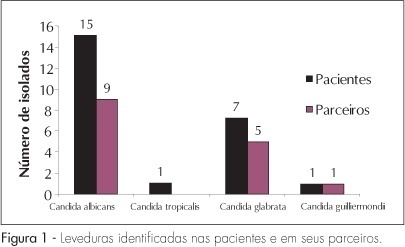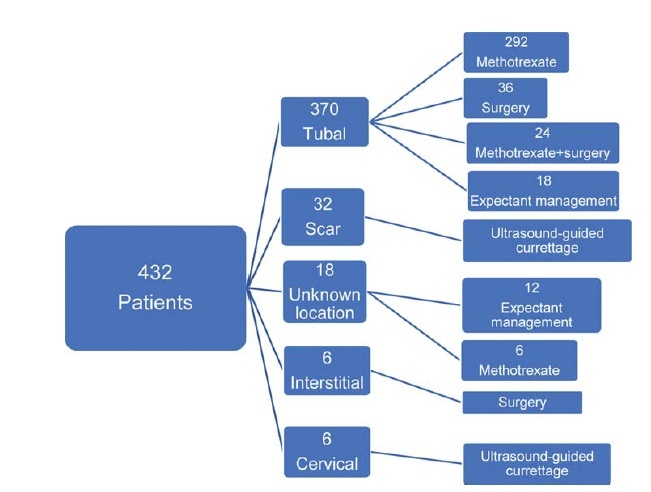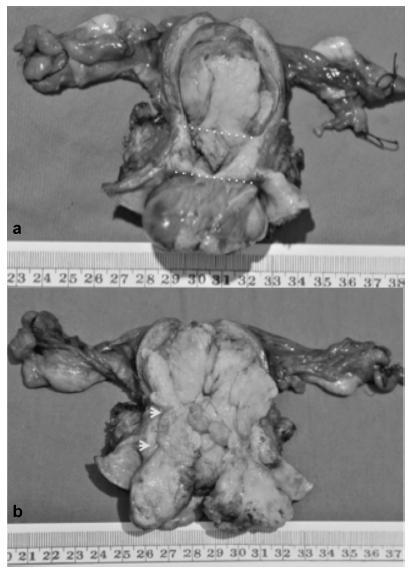Summary
Revista Brasileira de Ginecologia e Obstetrícia. 2005;27(2):80-85
DOI 10.1590/S0100-72032005000200007
PURPOSE: to evaluate the evolution of pregnancy and the maternofetal prognosis in women with uterine leiomyomas. METHODS: a descriptive retrospective analysis of the medical records of 75 pregnant women with leiomyomas attended at the University Hospital, Faculty of Medicine of Ribeirão Preto, University of São Paulo, from January 1992 to January 2002. RESULTS: seventy-five pregnant women with leiomyomas were identified in a population of 34,467 pregnant women attended during this period (incidence of 0.2%). The diagnosis was made before pregnancy in 18 patients (24%), during the current pregnancy in 41 (54.6%), and during cesarean section in 16 (21.3%), of whom only six were not submitted to ultrasound scan during the prenatal period. Ten deliveries with preterm fetuses and five cases of premature rupture of the amniotic membranes were observed. Forty-seven patients (75.8%) were submitted to cesarean section, with the indication being directly related to the leiomyomas in 38.3% of them (anomalous presentation, obstruction of the birth canal, or uterine scar due to a previous myomectomy). Four cases of central necrosis, two cases of hyaline degeneration and one case of malignant potential of the leiomyoma were identified in patients submitted to postpartum myomectomy or hysterectomy. Sixty-one newborns (98.4%) had an Apgar score above 7 at the fifth minute of life, and surgery did not lead to a worse maternofetal prognosis when performed during pregnancy. CONCLUSIONS: the incidence of leiomyomas during pregnancy was 0.2% during the study period, with ultrasonography failing to diagnose 10 patients. Cesarean section was frequently indicated for this group of patients, but the presence of leiomyomas during pregnancy did not compromise the Apgar score of the newborns.
Summary
Revista Brasileira de Ginecologia e Obstetrícia. 2012;34(2):80-85
DOI 10.1590/S0100-72032012000200007
PURPOSE: To evaluate the clinical outcomes after a minimum period of 5 years of follow-up of patients with abnormal uterine bleeding of benign etiology who underwent endometrial ablation, analyzing the success rate of treatment defined as patient satisfaction and improvement in uterine abnormal bleeding, as well as late complications and factors associated with recurrence of symptoms. METHODS: A cross-sectional survey was conducted after a minimum period of 5 years after surgery in patients who underwent the procedure between 1999 and 2004. We analyzed the following data: age at the time of surgery, immediate and late complications and associated factors. Logistic regression with Odds Ratio (OR) calculation was performed to evaluate possible associations between the success rate of surgery and the analyzed variables. RESULTS: A total of 114 patients underwent endometrial ablation between March 1999 and April 2004. The median follow-up was 82 months. The logistic regression model allowed the correct prediction of the success of endometrial ablation in 80.6% of cases. Age was directly related to the success of the procedure (OR=1.2; p=0.003) and previous tubal ligation showed a negative association with the success of endometrial ablation (OR=0.3; p=0.049). Among the patients with treatment failure, 21 (72.4%) underwent hysterectomy. In one of the hysterectomy cases, hydro/hematosalpinx was confirmed by the anatomopathological exam, characterizing the postablation-tubal sterilization syndrome. CONCLUSION: Endometrial ablation has proven to be a worthwhile treatment option, maintaining high rates of patient satisfaction, even over long-term follow-up. The age at endometrial ablation influenced the therapeutic success. Further studies are needed to evaluate the factors that may influence the future indication for the procedure in selected cases.
Summary
Revista Brasileira de Ginecologia e Obstetrícia. 2017;39(2):80-85
To evaluate the association of age at first sexual intercourse with the results of the cervicovaginal cytology.
Observational analytical study about the prevalence of altered cervicovaginal cytology results in women aged between 18 and 34 years from a densely populated area in Brazil, during 10 years. The patients were stratified into 2 categories according to their age at first sexual intercourse (13-16 years and 17-24 years).
From the total of 2,505,154 exams, 898,921 tests were in accordance with the inclusion criteria. Considering women with 4 years or less from the first sexual intercourse as a reference, those with 5 to 9 years and 10 years or more showed a higher prevalence of high-grade squamous intraepithelial lesions (HSILs). Women with an earlier onset of sexual intercourse (13-16 years) showed higher prevalence ratios for atypical squamous cells (ASC), low-grade squamous intraepithelial lesion (LSIL) and HSIL. The prevalence ratio for HSIL adjusted by age at diagnosis and by age at first sexual intercourse was higher only for women with an earlier onset of sexual intercourse.
The age of first sexual intercourse could be a variable that might qualify the selection among young women who are really at a higher risk for HSIL.
Summary
Revista Brasileira de Ginecologia e Obstetrícia. 2008;30(2):80-86
DOI 10.1590/S0100-72032008000200006
PURPOSE: to describe the clinical and laboratorial profile of HELLP syndrome patients admitted at an Obstetric Intensive Care Unit (ICU) and included in a randomized clinical trial to evaluate the efficacy of dexamethasone in this clinical setting. METHODS: the present study is a secondary analysis of a randomized clinical trial design to evaluate the efficacy of dexamethasone in patients with HELLP syndrome. This sample of patients was composed of patients in the puerperium, with the diagnosis of HELLP syndrome (diagnosis made before or after delivery) who were not chronic corticosteroid users and not carriers of any chronic disease which could modify HELLP syndrome's laboratorial parameters. Patients who were too critical or whose condition did not allow them to consent to participate were not included. Data were extracted from the records used in the randomized clinical trial. Age, parity, gestational age at admission and delivery, time of diagnosis (before or after delivery), HELLP syndrome classification (partial or complete), arterial blood pressure, and diuresis at admission were considered for analysis. Among laboratorial findings, hemoglobin, platelet count, liver enzymes, LDH, and serum bilirubin were analyzed. Complications presented by the patients were also analyzed as well as need of blood transfusions and duration of hospitalization. Analysis was made by the Epi-Info 3.3.2 program. RESULTS: one hundred and five patients were analyzed. Age varied from 14 to 49 years (means of 26.7). Regarding parity, 56 patients (53.8%) were primiparas. Analyzing the timing of the diagnosis, 47 patients (45.2%) had the diagnosis before delivery. The mean gestational age in these patients was 32.4 weeks. Hemorrhagic manifestations were observed in 36 patients (34.3%), oliguria was present in 49 patients (46.7%) and criteria for acute renal failure were seen in 21 (20%) of the cases. Hemotransfusions were necessary in 35 (33.3%) patients. Seven patients (6.7%) had pulmonary edema and four patients died, corresponding to 3.8% of the cases. The mean time from diagnosis of HELLP syndrome to discharge or death was 10.3 days, varying from 1 to 33 days. CONCLUSIONS: HELLP syndrome is an ominous diagnosis, which implicates in elevated maternal morbimortality. Among complications, oliguria and hemorrhagic manifestations were the most common findings and hemotransfusions were frequently required. Lethality reached 3.8%.

Summary
Revista Brasileira de Ginecologia e Obstetrícia. 2007;29(2):80-84
DOI 10.1590/S0100-72032007000200004
PURPOSE: to relate yeasts identified by laboratory tests to clinical signs and symptoms in patients with vulvovaginal candidiasis, and to investigate the importance of the sexual partners in the recurrence of the infection. METHODS: from July 2001 to July 2003, a sample of 179 patients aged from 18 to 65 years old, with clinical suspicion of fungal vaginitis were analyzed in a prospective study in Great São Paulo. Exclusion criteria included: pregnancy, impaired intrinsic or extrinsic immune response (including Aids), diabetes or immunosuppression; patients undergoing corticosteroid, antibiotic or hormone therapy, in post menopause, with intrauterine device (IUD) or making use of vaginal douches or spemicides. Samples of vaginal and penis secretions from partners of patients with relapse of vaginitis episodes were collected for microscopy and fungal culture. Fungal colonies isolated in CHROMagar Candida were identified by classical methods. Fisher's exact t-test was used to correlate the clinical picture with the yeasts isolated from patients. RESULTS: the most relevant clinical signs and symptoms were pruritus and vaginal discharge followed by erythema and edema, statistically independent from the etiological agent. Direct microscopy revealed yeasts in 77 patients with vulvovaginitis, and 40 Candida spp cultures were obtained. Candida albicans (70%), C. glabrata (20%), C. tropicalis (7,5%) and C. guilliermondii (2,5%) were identified. The yeasts prevalent in partners were C. albicans and C. glabrata. The same species were detected in female and male sex partners in 87% of the cases. CONCLUSIONS: fungal vulvovaginitis was more frequent in women between 18 and 34 years old. No correlation was observed between the species of yeast detected and clinical symptomatology. Sexual partners are important Candida spp reservoirs and may be related to the maintenance of the vulvovaginal candidiasis.

Summary
Revista Brasileira de Ginecologia e Obstetrícia. 2020;42(12):800-804
In recent years, there has been an increase in the incidence of ectopic pregnancies; therefore, it is important for tertiary centers to report their approaches and outcomes to expand and improve treatment modalities. The aim of the present study was to evaluate the general characteristics, treatment and outcomes of cases diagnosed with ectopic pregnancy.
In total, 432 patients treated for ectopic pregnancy between February 2016 and June 2019 were retrospectively evaluated.
Overall, 370 patients had tubal pregnancy, 32 had cesarean scar pregnancy, 18 had pregnancy of unknown location, 6 had cervical pregnancy, and 6 had interstitial pregnancy. The most important risk factors were advanced age (> 35 years; prevalence: 31.2%) and smoking (prevalence: 27.1%). Thirty patients who did not have any symptoms of rupture and whose human chorionic gonadotropin (β-hCG) levels were ≤ 200 mIU/ml were followed-up with expectant management, while 316 patients whose β-hCG levels were between 1,500 mIU/ml and 5,000 mIU/ml did not have an intrauterine gestational sac on the transvaginal or abdominal ultrasound, did not demonstrate findings of rupture, and were treated with a systemic multi-dose methotrexate treatment protocol. In total, 24 patients who did not respond to the medical treatment, 20 patients whose β-hCG levels were > 5,000 mIU/ml, 16 patients who had shown symptoms of rupture at the initial presentation, and 6 patients diagnosed with interstitial pregnancy underwent surgery. Patients with cervical and scar pregnancies underwent ultrasound-guided curettage, and no additional treatment was needed.
The fertility status of the patients, the clinical and laboratory findings, and the levels of β-hCG are the factors that must be considered in planning the appropriate treatment.

Summary
Revista Brasileira de Ginecologia e Obstetrícia. 2018;40(12):800-802
To describe a case of radiation-induced uterine carcinosarcoma 6 years after a cervical squamous cell carcinoma treatment, which imposed some diagnostic and management challenges.
A 57-year-old woman with a history of pelvic chemoradiotherapy ~ 6.5 years before the event described in this study, following an International Federation of Gynecology and Obstetrics (FIGO) stage IIB cervical cancer, presented with a cervical mass, involving the uterine cavity, the cervical canal and the upper two thirds of the vagina. The biopsy showed a poorly differentiated carcinoma, and a positron emission tomography (PET) scan excluded distant metastasis, although it was unable to define the origin of the tumor as either a new primary malignancy of the endometrium/cervix or as a cervical recurrence. Surgical staging procedure was performed, and the diagnosis was endometrial carcinosarcoma, FIGO stage IIB. The patient was not able to complete the adjuvant therapy, and the progression of the disease was remarkable.
The present case highlights one of the less common but more serious consequences of radiotherapy for cervical cancer, which has an increasing incidence in younger women, raising concerns about the long-termconsequences of its management.

Summary
Revista Brasileira de Ginecologia e Obstetrícia. 2022;44(8):802-803